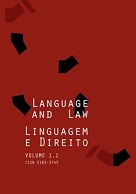Discurso, gênero e violência : uma análise de representações públicas do crime de estupro
Resumo
From a critical perspective, we can say that discourse shapes and defines
social life (Fairclough, 1992), that is, discourse not only reflects and represents
society, it also helps to signify, build and modify what we understand as ‘reality’.
One of the effects of the constitutive nature of discourse can be seen in the creation and transformation of social identities. Based on the theoretical frameworks of critical discourse analysis and gender studies, in this article I discuss how two dominant public discourses (media discourse and legal discourse) represent and construct rape – a social event structured around/by rigid and unequal relations
of power and gender – and its main participants, the rapist and the victim. I also
discuss the impact of these discursive representations on the police and on the
legal treatment given to perpetrators and victims of rape, as well as on the way
women conceive crimes of sexual violence, sexuality and their own identities.
Downloads
Publicado
Como Citar
Edição
Secção
Licença
Este trabalho está licenciado com uma Licença Creative Commons - Atribuição-NãoComercial 4.0 Internacional.







